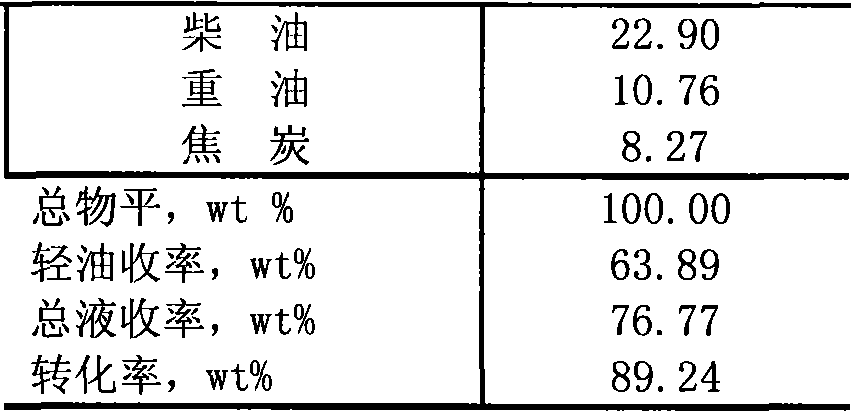Method for reliving FCC dead catalyst
A waste catalyst and catalyst technology, applied in molecular sieve catalysts, chemical instruments and methods, physical/chemical process catalysts, etc., can solve problems such as yield limitation, and achieve micro-reactive activity improvement, low coke yield, high liquefied gas and The effect of gasoline selectivity
- Summary
- Abstract
- Description
- Claims
- Application Information
AI Technical Summary
Problems solved by technology
Method used
Image
Examples
Embodiment 1
[0016] (1) Add 1 kg of FCC waste catalyst (from Qilu Petrochemical Shengli Oil Refinery) into a three-necked flask, add 8 liters of hydrochloric acid solution with a pH value of 1 under stirring conditions, and heat to 80°C;
[0017] (2) Add 5 liters of 0.05mol oxalic acid solution to the reaction system in step (1), and keep the reaction at 80° C. for 8 hours;
[0018] (3) After the reaction is finished and naturally cooled to room temperature, filter and wash the product until the pH of the filtrate is about 7; dry the washed product at 100°C for 24 hours to obtain the revived catalyst.
[0019] After testing, it was found that the specific surface area of the catalyst changed from 106.8m 2 / g increased to 211.7m after resurrection 2 / g, pore volume from 0.125cm 3 / g increased to 0.189cm 3 / g, the V content decreased from 4202ppm to 2902ppm, the Ni decreased from 1982ppm to 1718ppm, and the microreaction activity increased from 60.7 to 75.3.
Embodiment 2
[0021] (1) Add 1 kg of spent catalyst into a three-necked flask, add 4 liters of sulfuric acid solution with a pH value of 5 under stirring conditions, and heat to 120° C.;
[0022] (2) 3 liters of tartaric acid solutions of 0.2mol were added in the reaction system in step (1), and the reaction was maintained at 120° C. for 4 hours;
[0023] (3) After the reaction is finished and naturally cooled to room temperature, filter and wash the product until the pH of the filtrate is about 7; dry the washed product at 400°C for 24 hours to obtain the revived catalyst.
[0024] The physical structure of the obtained catalyst after the resurrection, the specific surface area is changed from 106.8m before the resurrection 2 / g increased to 205.4m after resurrection 2 / g, pore volume from 0.125cm 3 / g increased to 0.181cm 3 / g, the V content decreased from 4202ppm to 2890ppm, the Ni decreased from 1982ppm to 1722ppm, and the microreaction activity increased from 60.7 to 76.2.
Embodiment 3
[0026] (1) Add 1 kg of spent catalyst into a three-necked flask, add 6 liters of nitric acid solution with a pH value of 3 under stirring conditions, and heat to 110° C.;
[0027] (2) Add 4 liters of 0.1mol citric acid solution to the reaction system in step (1), and keep the reaction at 110° C. for 6 hours;
[0028] (3) After the reaction is finished and naturally cooled to room temperature, filter and wash the product until the pH of the filtrate is about 7; dry the washed product at 300°C for 24 hours to obtain the revived catalyst.
[0029] After testing, it was found that the specific surface area of the revived catalyst was 106.8m 2 / g increased to 224.7m after resurrection 2 / , pore volume from 0.125cm 3 / g increased to 0.195cm 3 / g, the V content decreased from 4202ppm to 2815ppm, the Ni decreased from 1982ppm to 1678ppm, and the microreaction activity increased from 60.7 to 78.4.
PUM
 Login to View More
Login to View More Abstract
Description
Claims
Application Information
 Login to View More
Login to View More - R&D
- Intellectual Property
- Life Sciences
- Materials
- Tech Scout
- Unparalleled Data Quality
- Higher Quality Content
- 60% Fewer Hallucinations
Browse by: Latest US Patents, China's latest patents, Technical Efficacy Thesaurus, Application Domain, Technology Topic, Popular Technical Reports.
© 2025 PatSnap. All rights reserved.Legal|Privacy policy|Modern Slavery Act Transparency Statement|Sitemap|About US| Contact US: help@patsnap.com


